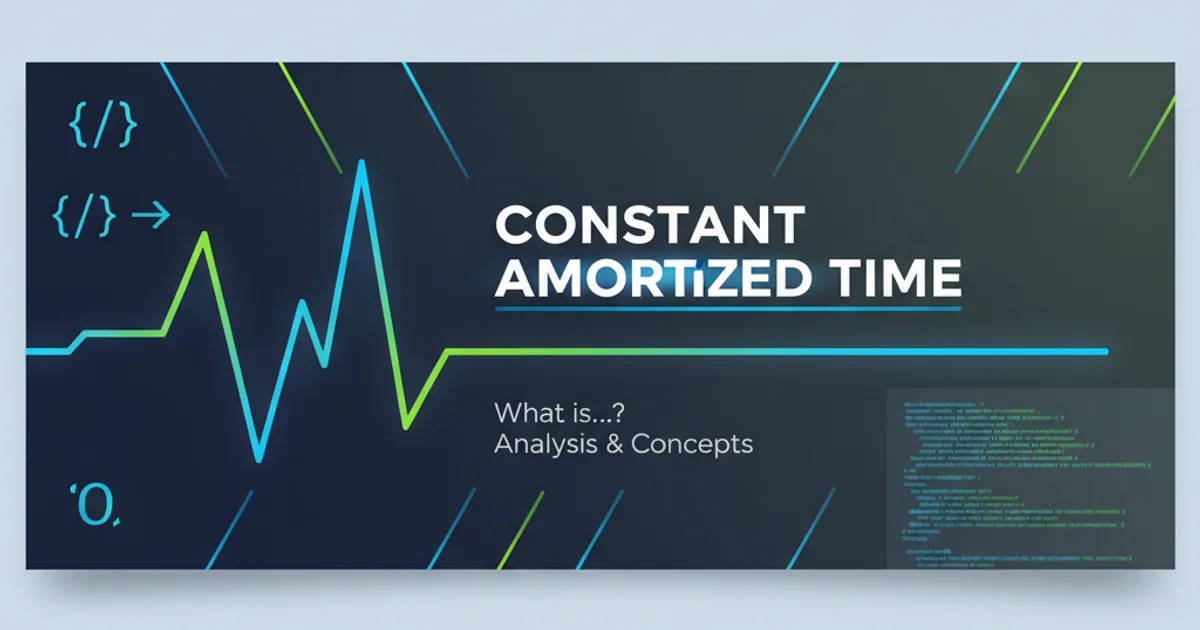What is Constant Amortized Time?
Categories:
Understanding Constant Amortized Time Complexity

Explore the concept of constant amortized time, a crucial aspect of algorithm analysis, and how it differs from strict constant time.
When analyzing algorithms, we often talk about time complexity using Big O notation. While O(1) (constant time) is straightforward, meaning an operation takes the same amount of time regardless of input size, O(1) amortized time is a more nuanced concept. It signifies that while a single operation might occasionally be expensive, the average cost of a sequence of operations remains constant. This article delves into what constant amortized time means, why it's important, and common data structures that exhibit this behavior.
What is Amortized Analysis?
Amortized analysis is a method for analyzing the time complexity of a sequence of operations, where the average cost per operation is considered, rather than the worst-case cost of any single operation. It's particularly useful for data structures where most operations are fast, but a few operations are very slow. Instead of reporting the worst-case time for a single operation, which might be misleadingly high, amortized analysis provides a more realistic average performance over a series of operations.
flowchart TD
A[Start Sequence of Operations]
B{Is current operation expensive?}
C[Perform fast operation (e.g., O(1))]
D[Perform expensive operation (e.g., O(N))]
E[Distribute cost of expensive operation over many fast operations]
F[End Sequence]
A --> B
B -->|No| C
B -->|Yes| D
C --> A
D --> E
E --> FConceptual flow of amortized analysis, showing how expensive operations are balanced by many cheap ones.
The Dynamic Array Example: A Classic Case
The most common example of a data structure with constant amortized time operations is a dynamic array (like ArrayList in Java or std::vector in C++). Appending an element to a dynamic array is typically an O(1) operation. However, when the array runs out of capacity, it must allocate a new, larger array (often double the size) and copy all existing elements to the new array. This resizing operation takes O(N) time, where N is the current number of elements.
If we only considered the worst-case, appending an element would be O(N). But with amortized analysis, we see that these O(N) resizes happen infrequently. For instance, if the array doubles its size each time it resizes, the cost of copying elements is spread out over many O(1) insertions. Over a sequence of N insertions, the total cost is O(N), making the average cost per insertion O(N)/N = O(1).
class DynamicArray:
def __init__(self):
self.capacity = 1
self.size = 0
self.array = [None] * self.capacity
def append(self, item):
if self.size == self.capacity:
# Resize operation - O(N) in worst case
self.capacity *= 2
new_array = [None] * self.capacity
for i in range(self.size):
new_array[i] = self.array[i]
self.array = new_array
print(f"Resized array to capacity: {self.capacity}")
self.array[self.size] = item
self.size += 1
def __str__(self):
return str(self.array[:self.size])
# Example usage
arr = DynamicArray()
for i in range(10):
print(f"Appending {i}")
arr.append(i)
print(f"Current array: {arr}, Size: {arr.size}, Capacity: {arr.capacity}")
Python implementation of a dynamic array demonstrating resizing behavior.
Other Examples and Importance
Beyond dynamic arrays, other data structures and algorithms also benefit from amortized analysis:
- Hash Tables: Operations like insertion and deletion are typically
O(1)on average, but arehashoperation (when the load factor gets too high) can takeO(N)time. Amortized analysis shows that these operations areO(1)amortized. - Disjoint Set Union (DSU): With path compression and union by rank/size, operations are nearly constant time, often expressed as
O(α(N)), whereαis the inverse Ackermann function, which grows extremely slowly and is effectively constant for all practical input sizes. - Binary Counters: Incrementing a binary counter can take
O(log N)in the worst case (flipping all bits), but over a sequence ofNincrements, the amortized cost isO(1)per increment.
Understanding constant amortized time is crucial for designing efficient systems. It allows developers to choose data structures that offer excellent average performance, even if occasional operations are costly, without being overly pessimistic about performance guarantees.